Quantitative Evaluation and Evolution of Overpressure in the Deep Layers of a Foreland Basin: Examples from the Lower Cretaceous Bashijiqike Formation in the Keshen Area, Kuqa Depression, Tarim Basin, China
Abstract
:1. Introduction
2. Geological Setting
2.1. Structural System
2.2. Petroleum System
3. Data and Methods
3.1. Drill Stem Test and Mud Weight Data
3.2. Well Log and Compaction Curve
3.3. Acoustic Transit–Vertical Effective Stress Crossplots
3.4. Earth Stress Field Simulation
3.5. Basin Simulation
4. Results
4.1. Overpressure in Sandstones
4.2. Characteristics of Mudstone Compaction Curve
4.3. Characteristics of Acoustic Transit–Vertical Effective Stress Crossplot
4.4. Earth Stress Distribution
4.5. Basin Modelling Results
5. Discussion
5.1. Quantitative Evaluation of Overpressure
5.1.1. Mudstone Disequilibrium Compaction Overpressure
5.1.2. Transfer Overpressure
5.1.3. Tectonic Compression Overpressure
5.2. Overpressure Evolution
5.2.1. Individual Well Pressure Evolution
5.2.2. Multi-Genetic Profile Pressure Evolution Profile
6. Conclusions
Author Contributions
Funding
Institutional Review Board Statement
Informed Consent Statement
Data Availability Statement
Acknowledgments
Conflicts of Interest
Appendix A
- Technical terms
- Mudstone disequilibrium compaction overpressure
- Transfer overpressure
- Tectonic compression overpressure
- Multi-genetic overpressure
- Pressure evolution
- Static rock pressure
- Wiley formula
- Brittle deformation
- Plastic deformationPlastic deformation is a deformation that cannot be restored by itself. Engineering materials and components will be permanently deformed after the load exceeds the elastic deformation range, that is, after the load is removed, there will be unrecoverable deformation, or residual deformation, which is plastic deformation.
- Quantitative evaluation model of fault-transfer overpressure in the deep layers of a foreland basin:

- Advantages of model

- Limitations of the model
- Application of model
- Quantitative evaluationmodel of tectonic compressional overpressure in deep foreland basin
- Advantages of model
- Limitations of the model
References
- Hao, F.; Zou, H.; Gong, Z.; Yang, S.; Zeng, Z. Hierarchies of overpressure retardation of organic matter maturation: Case studies from petroleum basins in China. AAPG Bull. 2007, 91, 1467–1498. [Google Scholar] [CrossRef]
- Zhang, J.C. Effective stress, porosity, velocity, and abnormal pore pressure prediction accounting for compaction disequilibrium and unloading. Mar. Petrol. Geol. 2013, 45, 2–11. [Google Scholar] [CrossRef]
- Guo, X.; He, S.; Liu, K.; Song, G.; Wang, X.; Shi, Z. Oil generation as the dominant overpressure mechanism in the cenozoic dongying depression, Bohai Bay basin, China. AAPG Bull. 2010, 94, 1859–1881. [Google Scholar] [CrossRef]
- Guo, X.; Liu, K.; Jia, C.; Song, Y.; Zhao, M.; Zhuo, Q.; Lu, X. Constraining tectonic compression processes by reservoir pressure evolution: Overpressure generation and evolution in the kelasu thrust belt of kuqa foreland basin, NW China. Mar. Pet. Geol. 2016, 72, 30–44. (In Chinese) [Google Scholar] [CrossRef]
- Tingay, M.R.; Hillis, R.R.; Swarbrick, R.E.; Morley, C.K.; Damit, A.R. Origin of overpressure and pore-pressure prediction in the Baram province, Brunei. AAPG Bull. 2009, 93, 51–74. [Google Scholar] [CrossRef]
- Wang, X.; He, S.; Wei, A.; Liu, Q.; Liu, C. Typical disequilibrium compaction caused overpressure of paleocene dongying formation in northwest liaodongwan depression, Bohai Bay basin, China. J. Petrol. Sci. Eng. 2016, 147, 726–734. [Google Scholar] [CrossRef]
- Yang, Z.; He, S.; Li, Q.; Lin, S.; Pan, S. Geochemistry characteristics and significance of two petroleum systems near top overpressured surface in central Junggar Basin, NW China. Mar. Petrol. Geol. 2016, 75, 341–355. [Google Scholar] [CrossRef]
- Zhang, J.; He, S.; Wang, Y.; Wang, Y.; Hao, X.; Luo, S.; Li, P.; Dang, X.; Yang, R. Main mechanism for generating overpressure in the paleogene source rock series of the chezhen depression, Bohai Bay basin, China. J. Earth Sci. 2018; in press. [Google Scholar]
- Bowers, G.L. Detecting high overpressure. Lead. Edge 2002, 21, 174–177. [Google Scholar] [CrossRef]
- Li, J.; Zhao, J.; Hou, Z.; Zhang, S.; Chen, M. Origins of overpressure in the central Xihu depression of the East China Sea shelf basin. AAPG Bull. 2021, 105, 1627–1659. [Google Scholar] [CrossRef]
- Fan, C.Y.; Wang, Z.L. Identification and calculation of transfer overpressure in the northern Qaidam Basin, northwest China. AAPG Bull. 2016, 100, 23–39. [Google Scholar] [CrossRef]
- Li, C.; Zhang, L.K.; Luo, X.R.; Lei, Y.H.; Yu, L.; Cheng, M.; Wang, Y.S.; Wang, Z.L. Overpressure generation by disequilibrium compaction or hydrocarbon generation in the Paleocene Shahejie Formation in the Chezhen Depression: Insights from logging responses and basin modeling. Mar. Petrol. Geol. 2021, 133, 105–258. [Google Scholar] [CrossRef]
- Luo, X.; Wang, Z.; Zhang, L.; Yang, W.; Liu, L. Overpressure generation and evolution in a compressional tectonic setting, the southern margin of Junggar Basin, northwestern China. AAPG Bull. 2007, 91, 1123–1139. [Google Scholar] [CrossRef]
- Zeng, L.B.; Wang, H.J.; Gong, L.; Liu, B.M. Impacts of the tectonic stress field on natural gas migration and accumulation: A case study of the Kuqa Depression in the Tarim Basin, China. Mar. Petrol. Geol. 2010, 27, 1616–1627. [Google Scholar] [CrossRef]
- Aplin, A.C.; Larter, S.R.; Bigge, M.A.; Macleod, G.; Swarbrick, R.E.; Grunberger, D. PVTX history of the North Sea’s Judy oilfield. J. Geochem. Explor. 2000, 69–70, 641–644. [Google Scholar] [CrossRef]
- Gutierrez, M.; Wangen, M. Modeling of compaction and overpressuring in sedimentary basins. Mar. Petrol. Geol. 2005, 22, 351–363. [Google Scholar] [CrossRef]
- Wang, B.; Qiu, N.; Amberg, S.; Duan, Y.; Littke, R. Modelling of pore pressure evolution in a compressional tectonic setting: The Kuqa Depression, Tarim Basin, northwestern China. Mar. Petrol. Geol. 2022, 146, 105936. [Google Scholar] [CrossRef]
- Jia, C.Z.; Li, Q.M. Petroleum geology of Kela-2, the most productive gas field in China. Mar. Petrol. Geol. 2008, 25, 335–343. [Google Scholar]
- Kong, L.T.; Chen, H.H.; Ping, H.W.; Zhai, P.Q.; Liu, Y.H.; Zhu, J.Z. Formation pressure modeling in the Baiyun Sag, northern South China Sea: Implications for petroleum exploration in deep-water areas. Mar. Petrol. Geol. 2018, 97, 154–168. [Google Scholar] [CrossRef]
- Liang, D.; Zhang, S.; Chen, J.; Wang, F.; Wang, P. Organic geochemistry of oil and gas in the Kuqa depression, Tarim Basin, NW China. Org. Geochem. 2003, 34, 873–888. [Google Scholar] [CrossRef]
- Milliken, K.L.; Rudnicki, M.; Awwiller, D.N.; Zhang, T. Organic matter-hosted pore system, Marcellus Formation (Devonian), Pennsylvania. AAPG Bull. 2013, 97, 177–200. [Google Scholar] [CrossRef]
- Mastalerz, M.; Schimmelmann, A.; Drobniak, A.; Chen, Y. Porosity of Devonian and Mississippian New Albany Shale across a maturation gradient: Insights from organic petrology, gas adsorption, and mercury intrusion. AAPG Bull. 2013, 97, 1621–1643. [Google Scholar] [CrossRef]
- Zhang, L.; Li, C.; Luo, X.; Zhang, Z.; Zeng, Z.; Ren, X.; Lei, Y.; Zhang, M.; Xie, J.; Cheng, M.; et al. Vertically transferred overpressures along faults in mesozoic reservoirs in the central junggar basin, northwestern China: Implications for hydrocarbon accumulation and preservation. Mar. Pet. Geol. 2023, 150, 106152. [Google Scholar] [CrossRef]
- Luo, X.; Dong, W.; Yang, J.; Yang, W. Overpressuring mechanisms in the Yinggehai Basin, South China Sea. AAPG Bull. 2003, 87, 629–645. [Google Scholar] [CrossRef]
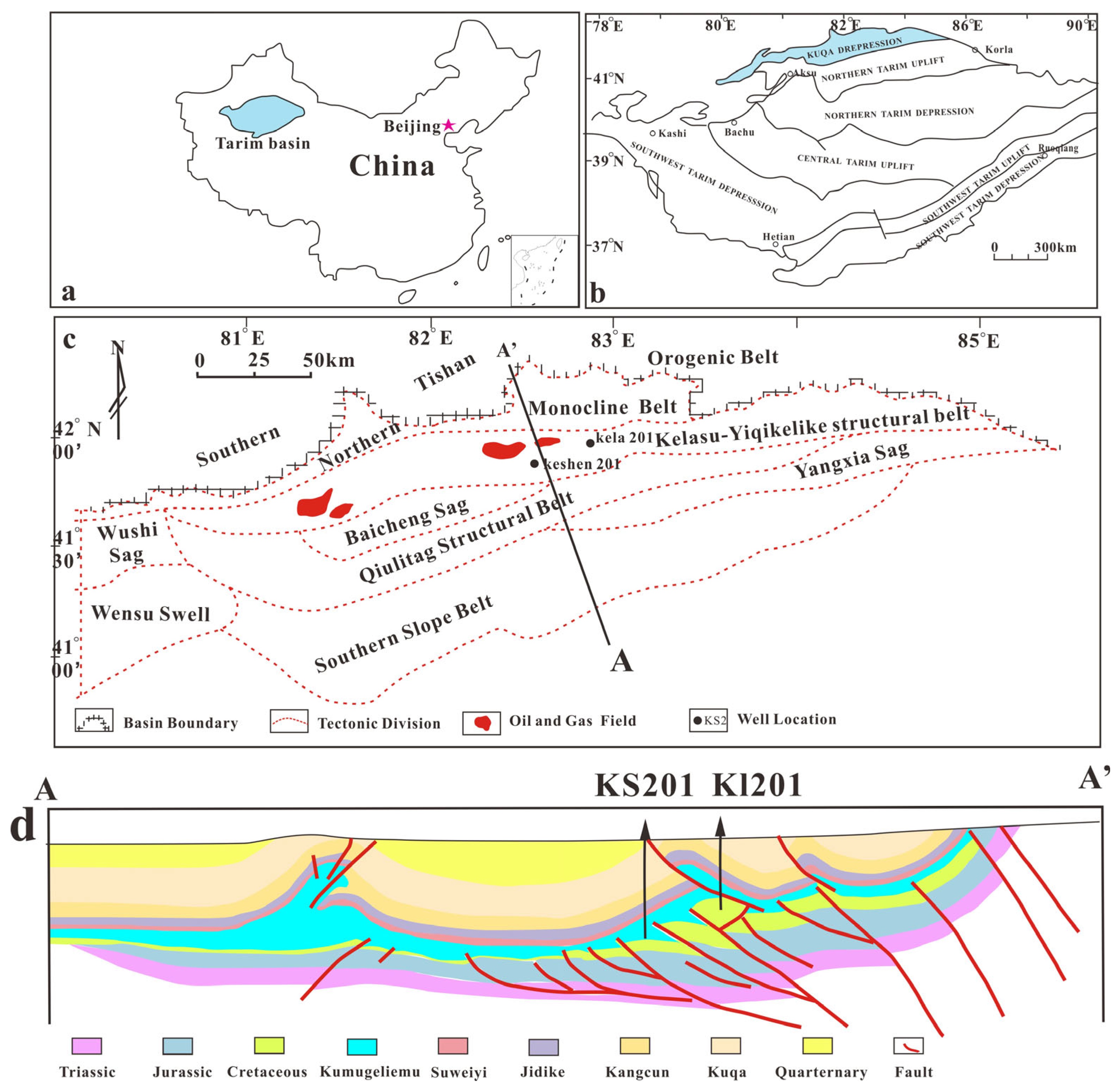
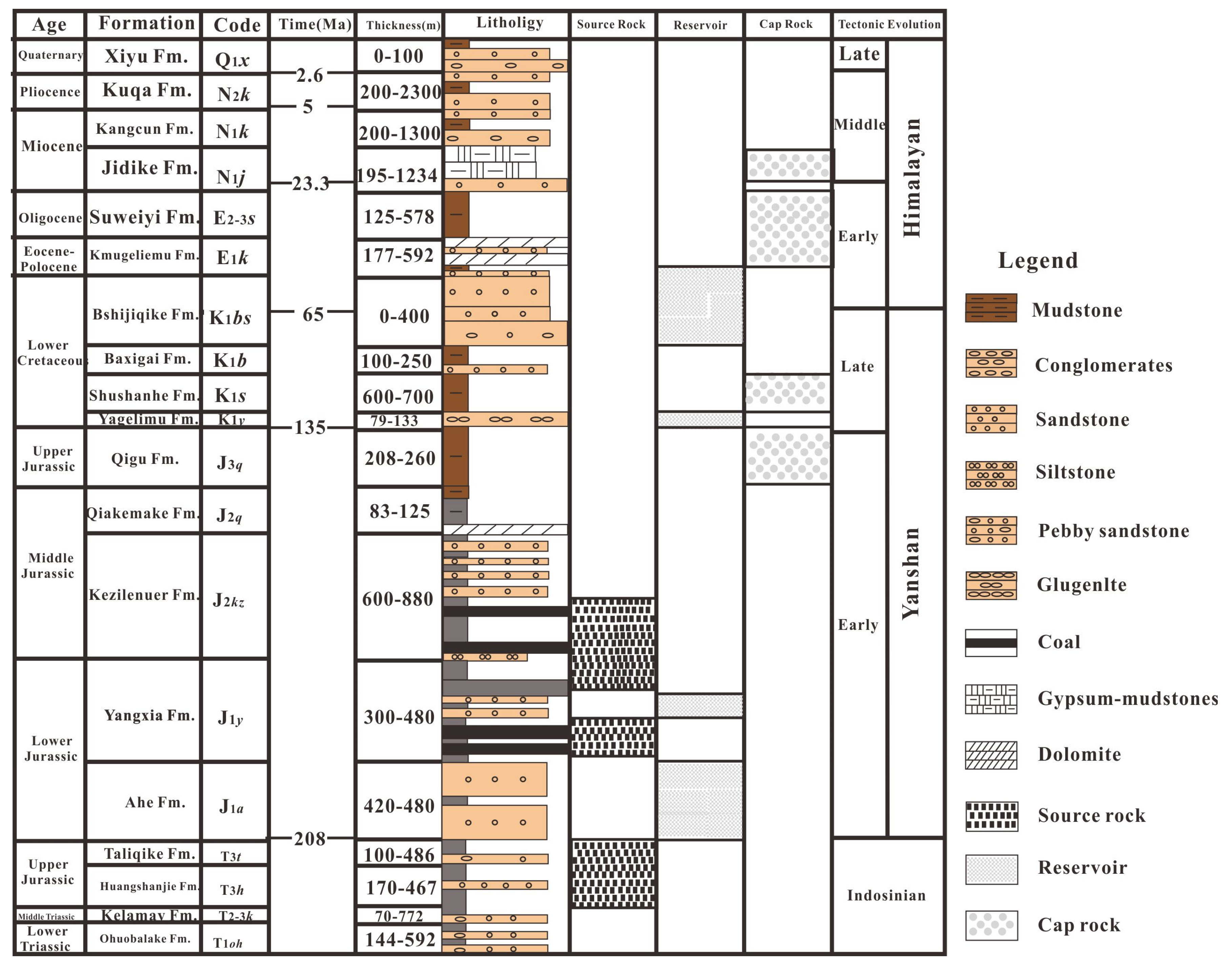
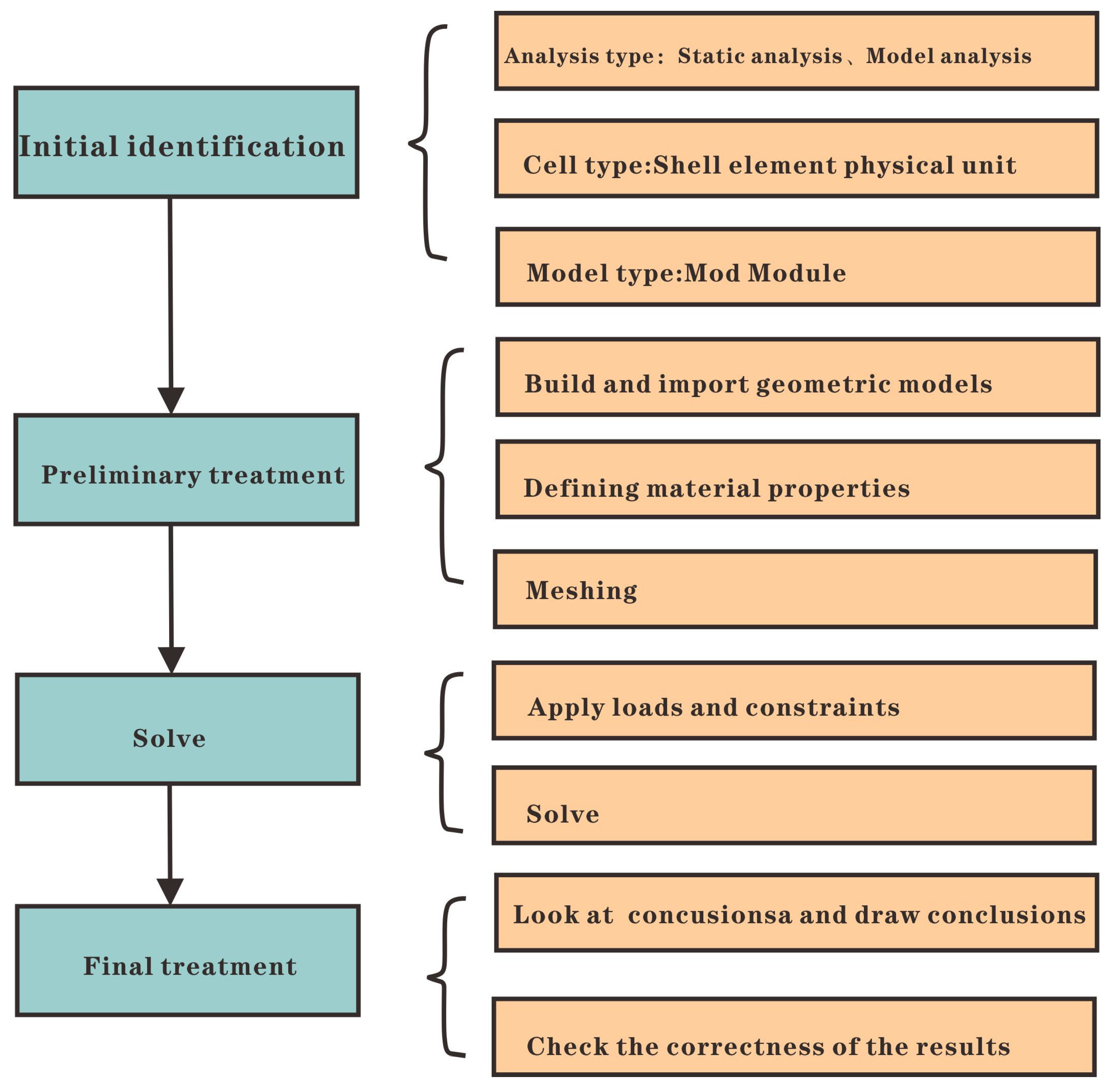

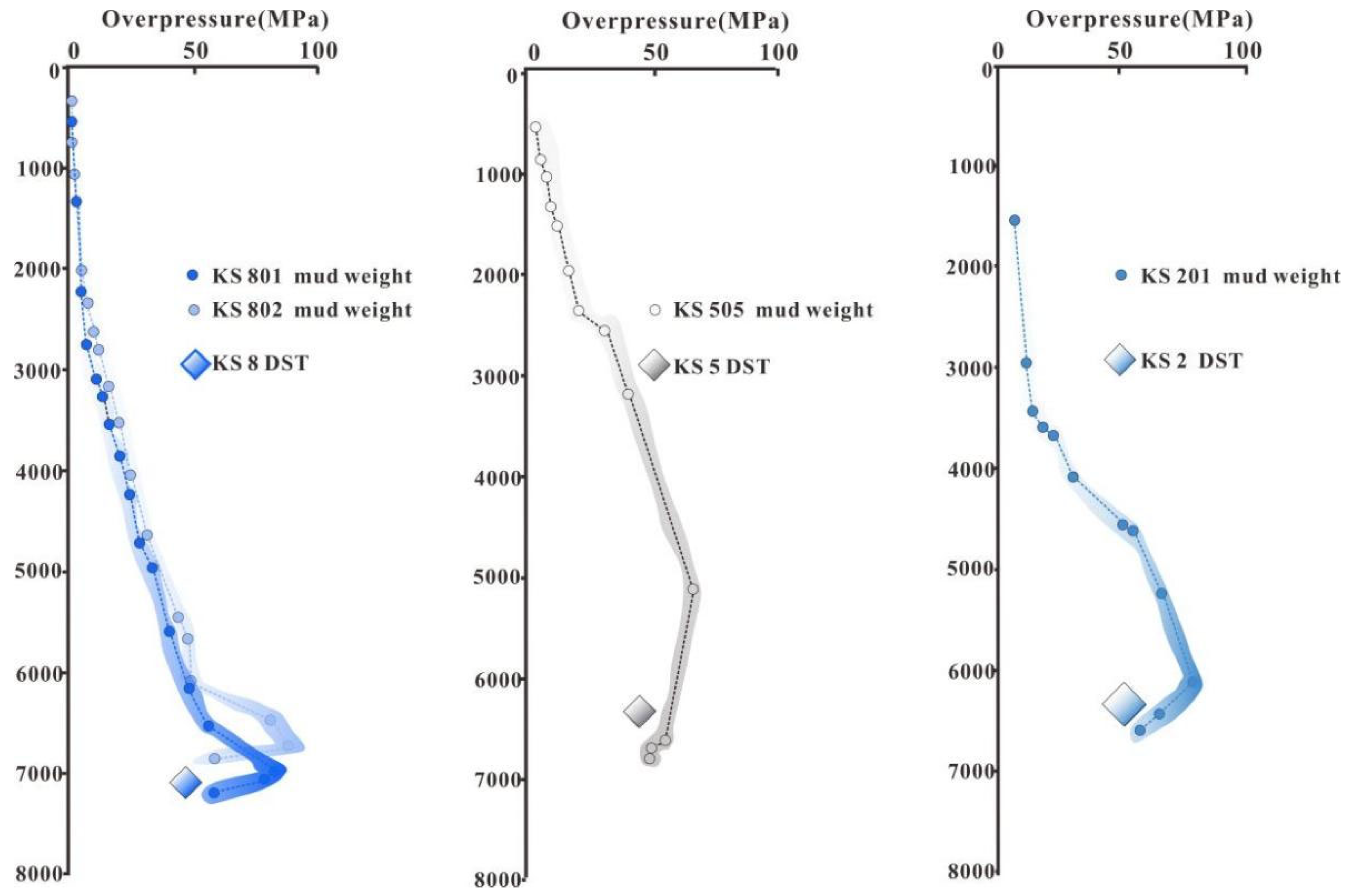
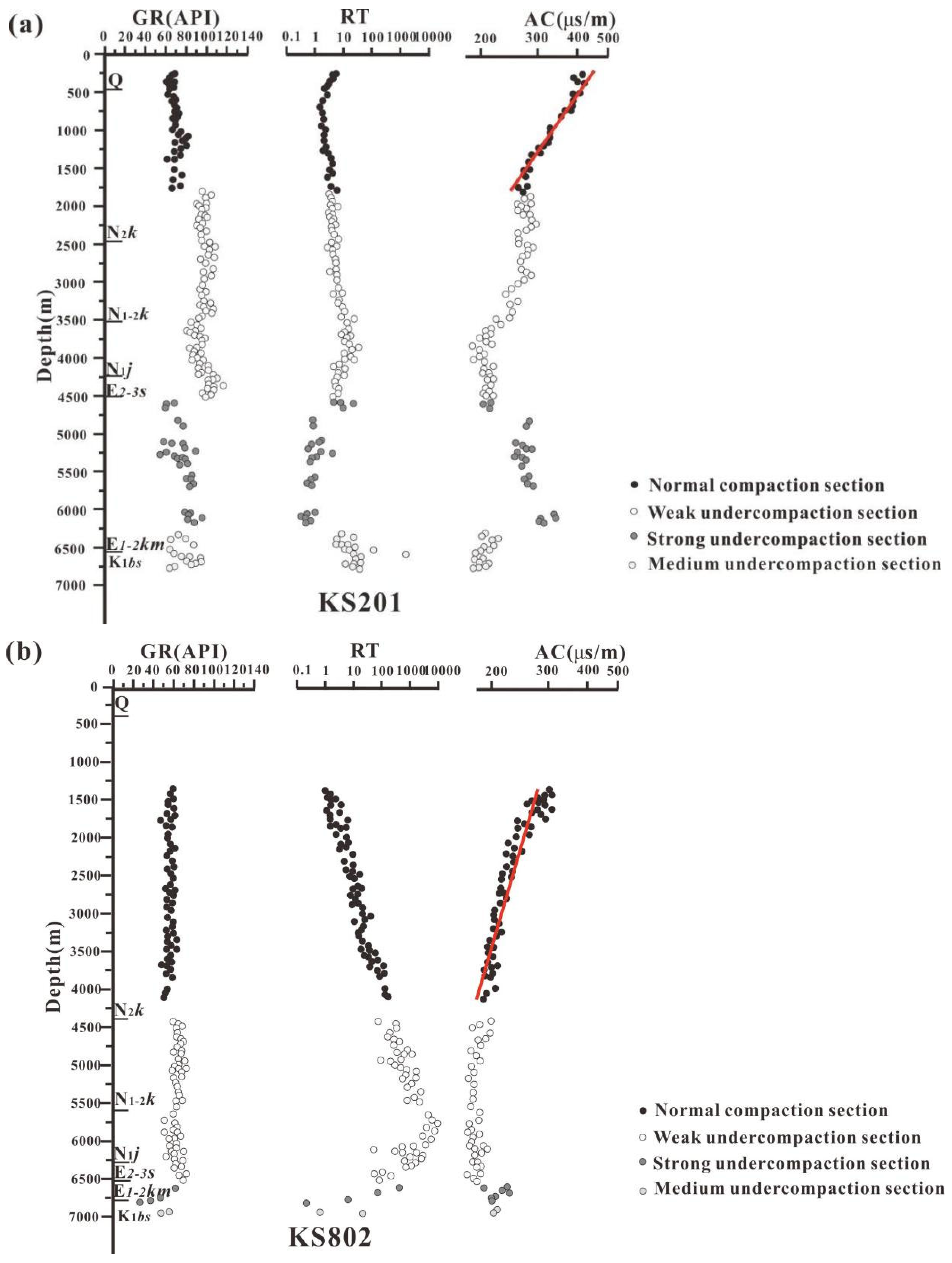

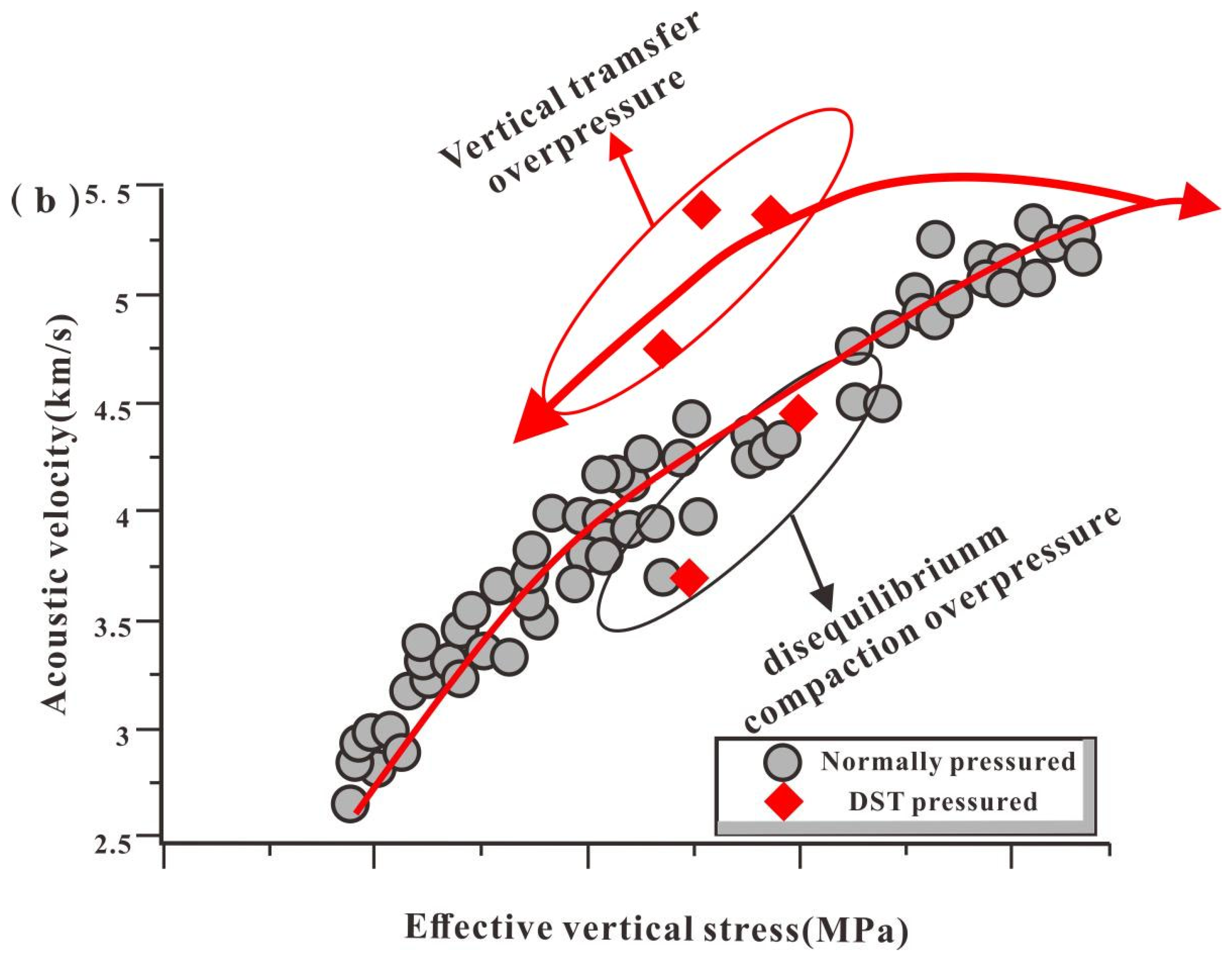
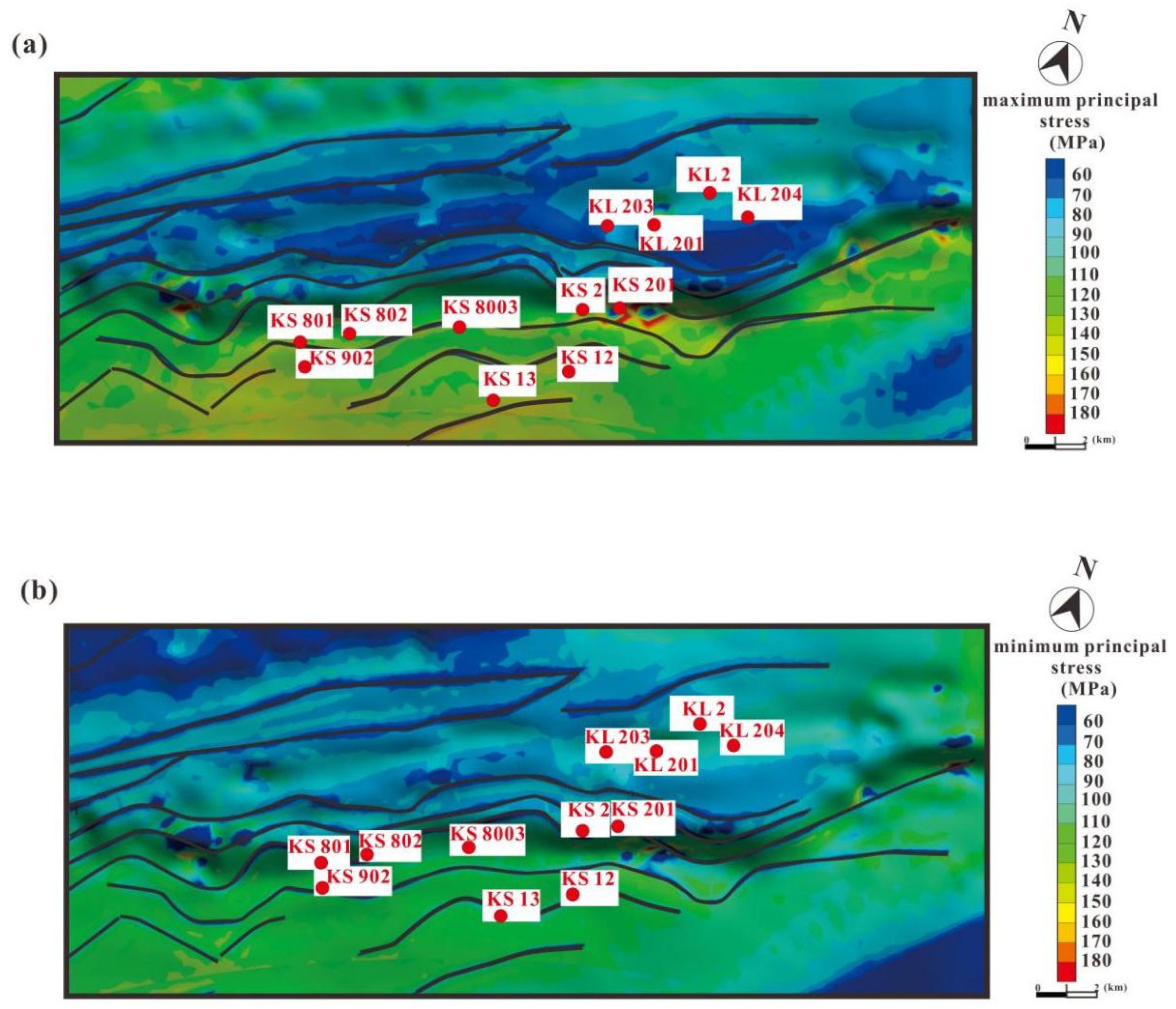




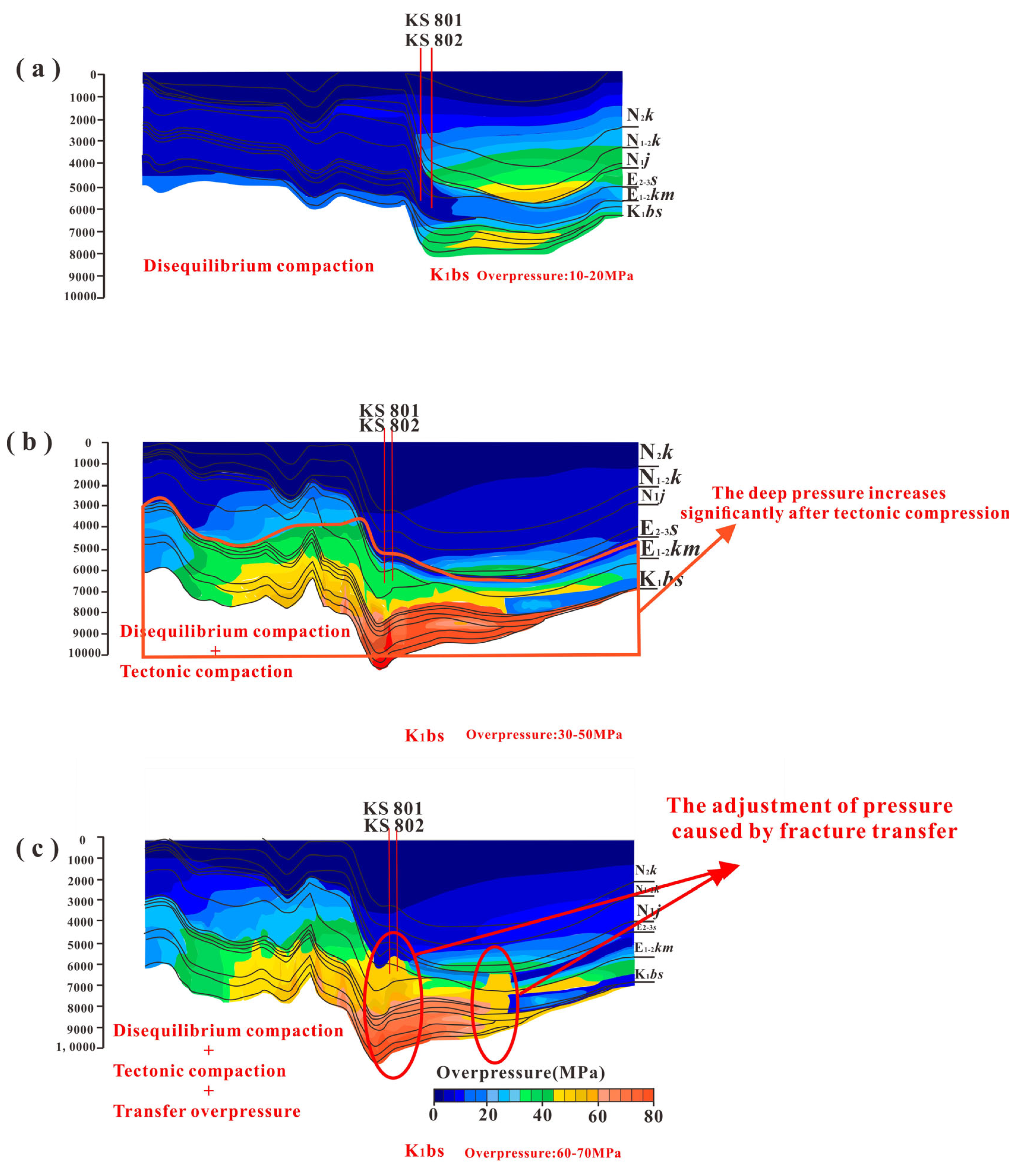
Disclaimer/Publisher’s Note: The statements, opinions and data contained in all publications are solely those of the individual author(s) and contributor(s) and not of MDPI and/or the editor(s). MDPI and/or the editor(s) disclaim responsibility for any injury to people or property resulting from any ideas, methods, instructions or products referred to in the content. |
© 2024 by the authors. Licensee MDPI, Basel, Switzerland. This article is an open access article distributed under the terms and conditions of the Creative Commons Attribution (CC BY) license (https://creativecommons.org/licenses/by/4.0/).
Share and Cite
Wen, C.; Wang, Z. Quantitative Evaluation and Evolution of Overpressure in the Deep Layers of a Foreland Basin: Examples from the Lower Cretaceous Bashijiqike Formation in the Keshen Area, Kuqa Depression, Tarim Basin, China. Sustainability 2024, 16, 10884. https://doi.org/10.3390/su162410884
Wen C, Wang Z. Quantitative Evaluation and Evolution of Overpressure in the Deep Layers of a Foreland Basin: Examples from the Lower Cretaceous Bashijiqike Formation in the Keshen Area, Kuqa Depression, Tarim Basin, China. Sustainability. 2024; 16(24):10884. https://doi.org/10.3390/su162410884
Chicago/Turabian StyleWen, Chenxi, and Zhenliang Wang. 2024. "Quantitative Evaluation and Evolution of Overpressure in the Deep Layers of a Foreland Basin: Examples from the Lower Cretaceous Bashijiqike Formation in the Keshen Area, Kuqa Depression, Tarim Basin, China" Sustainability 16, no. 24: 10884. https://doi.org/10.3390/su162410884
APA StyleWen, C., & Wang, Z. (2024). Quantitative Evaluation and Evolution of Overpressure in the Deep Layers of a Foreland Basin: Examples from the Lower Cretaceous Bashijiqike Formation in the Keshen Area, Kuqa Depression, Tarim Basin, China. Sustainability, 16(24), 10884. https://doi.org/10.3390/su162410884




